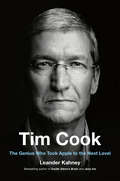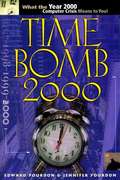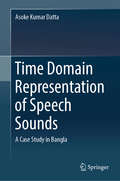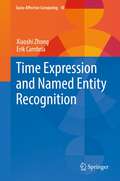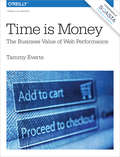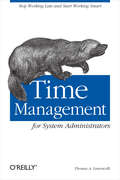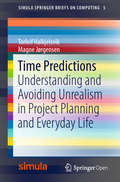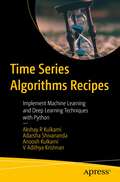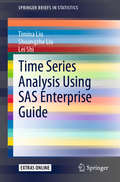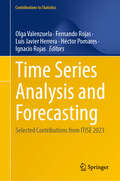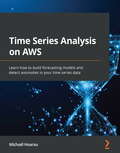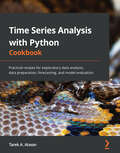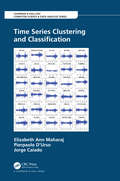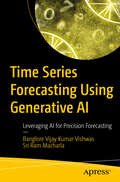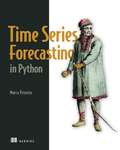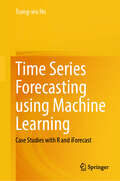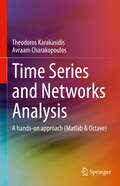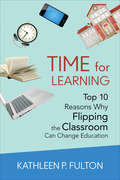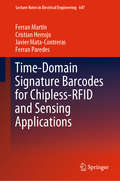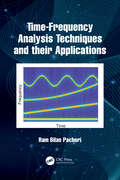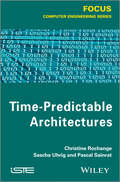- Table View
- List View
Tim Cook: The Genius Who Took Apple to the Next Level
by Leander KahneyJournalist Leander Kahney reveals how CEO Tim Cook has led Apple to astronomical success after the death of Steve Jobs in 2011. The death of Steve Jobs left a gaping void at one of the most innovative companies of all time. Jobs wasn't merely Apple's iconic founder and CEO; he was the living embodiment of a global megabrand. It was hard to imagine that anyone could fill his shoes--especially not Tim Cook, the intensely private executive who many thought of as Apple's "operations drone."But seven years later, as journalist Leander Kahney reveals in this definitive book, things at Apple couldn't be better. Its stock has nearly tripled, making it the world's first trillion dollar company. Under Cook's principled leadership, Apple is pushing hard into renewable energy, labor and environmentally-friendly supply chains, user privacy, and highly-recyclable products. From the massive growth of the iPhone to lesser-known victories like the Apple Watch, Cook is leading Apple to a new era of success.Drawing on access with several Apple insiders, Kahney tells the inspiring story of how one man attempted to replace someone irreplacable, and--through strong, humane leadership, supply chain savvy, and a commitment to his values--succeeded more than anyone had thought possible.
Time Domain Representation of Speech Sounds: A Case Study In Bangla
by Asoke Kumar DattaThe book presents the history of time-domain representation and the extent of its development along with that of spectral domain representation in the cognitive and technology domains. It discusses all the cognitive experiments related to this development, along with details of technological developments related to both automatic speech recognition (ASR) and text to speech synthesis (TTS), and introduces a viable time-domain representation for both objective and subjective analysis, as an alternative to the well-known spectral representation.The book also includes a new cohort study on the use of lexical knowledge in ASR. India has numerous official dialects, and spoken-language technology development is a burgeoning area. In fact TTS and ASR taken together constitute the most important technology for empowering people. As such, the book describes time domain representation in such a way that it can be easily and seamlessly incorporated into ASR and TTS research and development. In short, it is a valuable guidebook for the development of ASR and TTS in all the Indian Standard Dialects using signal domain parameters.
Time Expression and Named Entity Recognition (Socio-Affective Computing #10)
by Erik Cambria Xiaoshi ZhongThis book presents a synthetic analysis about the characteristics of time expressions and named entities, and some proposed methods for leveraging these characteristics to recognize time expressions and named entities from unstructured text. For modeling these two kinds of entities, the authors propose a rule-based method that introduces an abstracted layer between the specific words and the rules, and two learning-based methods that define a new type of tagging scheme based on the constituents of the entities, different from conventional position-based tagging schemes that cause the problem of inconsistent tag assignment. The authors also find that the length-frequency of entities follows a family of power-law distributions. This finding opens a door, complementary to the rank-frequency of words, to understand our communicative system in terms of language use.
Time Is Money: The Business Value of Web Performance
by Tammy EvertsIf you want to convince your organization to conduct a web performance upgrade, this concise book will strengthen your case. Drawing upon her many years of web performance research, author Tammy Everts uses cases studies and other data to explain how web page speed and availability affect a host of business metrics. You’ll also learn how our human neurological need for quick, uncomplicated processes drives these metrics.Ideal for managers, this book’s case studies demonstrate how Walmart, Staples.com, Mozilla, and other organizations significantly improved conversion rates through simple upgrades. Find out why happy customers return, while frustrated users can send your metrics—and your domain—into a tailspin.You’ll explore:What happens neurologically when people encounter slow or interrupted processesHow page speed affects metrics in retail and other industries, from media sites to SaaS providersWhy internal applications are often slower than consumer apps, and how this hurts employee morale and productivityCommon performance problems and the various technologies created to fight themHow to pioneer new metrics, and create an organizational culture of performance
Time Management for System Administrators: Stop Working Late and Start Working Smart
by Thomas A. LimoncelliTime is a precious commodity, especially if you're a system administrator. No other job pulls people in so many directions at once. Users interrupt you constantly with requests, preventing you from getting anything done. Your managers want you to get long-term projects done but flood you with requests for quick-fixes that prevent you from ever getting to those long-term projects. But the pressure is on you to produce and it only increases with time. What do you do?The answer is time management. And not just any time management theory--you want Time Management for System Administrators, to be exact. With keen insights into the challenges you face as a sys admin, bestselling author Thomas Limoncelli has put together a collection of tips and techniques that will help you cultivate the time management skills you need to flourish as a system administrator.Time Management for System Administrators understands that an Sys Admin often has competing goals: the concurrent responsibilities of working on large projects and taking care of a user's needs. That's why it focuses on strategies that help you work through daily tasks, yet still allow you to handle critical situations that inevitably arise.Among other skills, you'll learn how to:Manage interruptionsEliminate timewastersKeep an effective calendarDevelop routines for things that occur regularlyUse your brain only for what you're currently working onPrioritize based on customer expectationsDocument and automate processes for faster executionWhat's more, the book doesn't confine itself to just the work environment, either. It also offers tips on how to apply these time management tools to your social life. It's the first step to a more productive, happier you.
Time Predictions: Understanding And Avoiding Unrealism In Project Planning And Everyday Life (Simula Springerbriefs On Computing Ser. #5)
by Torleif Halkjelsvik Magne JørgensenThis book is published open access under a CC BY 4.0 license.Predicting the time needed to complete a project, task or daily activity can be difficult and people frequently underestimate how long an activity will take. This book sheds light on why and when this happens, what we should do to avoid it and how to give more realistic time predictions. It describes methods for predicting time usage in situations with high uncertainty, explains why two plus two is usually more than four in time prediction contexts, reports on research on time prediction biases, and summarizes the evidence in support of different time prediction methods and principles. Based on a comprehensive review of the research, it is the first book summarizing what we know about judgment-based time predictions. Large parts of the book are directed toward people wishing to achieve better time predictions in their professional life, such as project managers, graphic designers, architects, engineers, film producers, consultants, software developers, or anyone else in need of realistic time usage predictions. It is also of benefit to those with a general interest in judgment and decision-making or those who want to improve their ability to predict and plan ahead in daily life.
Time Series Algorithms Recipes: Implement Machine Learning and Deep Learning Techniques with Python
by Adarsha Shivananda Anoosh Kulkarni V Adithya Krishnan Akshay R KulkarniThis book teaches the practical implementation of various concepts for time series analysis and modeling with Python through problem-solution-style recipes, starting with data reading and preprocessing. It begins with the fundamentals of time series forecasting using statistical modeling methods like AR (autoregressive), MA (moving-average), ARMA (autoregressive moving-average), and ARIMA (autoregressive integrated moving-average). Next, you'll learn univariate and multivariate modeling using different open-sourced packages like Fbprohet, stats model, and sklearn. You'll also gain insight into classic machine learning-based regression models like randomForest, Xgboost, and LightGBM for forecasting problems. The book concludes by demonstrating the implementation of deep learning models (LSTMs and ANN) for time series forecasting. Each chapter includes several code examples and illustrations. After finishing this book, you will have a foundational understanding of various concepts relating to time series and its implementation in Python. What You Will LearnImplement various techniques in time series analysis using Python.Utilize statistical modeling methods such as AR (autoregressive), MA (moving-average), ARMA (autoregressive moving-average) and ARIMA (autoregressive integrated moving-average) for time series forecasting Understand univariate and multivariate modeling for time series forecastingForecast using machine learning and deep learning techniques such as GBM and LSTM (long short-term memory) Who This Book Is ForData Scientists, Machine Learning Engineers, and software developers interested in time series analysis.
Time Series Analysis Using SAS Enterprise Guide (SpringerBriefs in Statistics)
by Timina Liu Shuangzhe Liu Lei ShiThis is the first book to present time series analysis using the SAS Enterprise Guide software. It includes some starting background and theory to various time series analysis techniques, and demonstrates the data analysis process and the final results via step-by-step extensive illustrations of the SAS Enterprise Guide software. This book is a practical guide to time series analyses in SAS Enterprise Guide, and is valuable resource that benefits a wide variety of sectors.
Time Series Analysis and Forecasting: Selected Contributions from ITISE 2023 (Contributions to Statistics)
by Ignacio Rojas Héctor Pomares Olga Valenzuela Fernando Rojas Luis Javier HerreraThis volume on the latest developments in the theory and applications of time series analysis and forecasting comprises a selection of refereed papers presented at the 9th International Conference on Time Series and Forecasting, ITISE 2023, held in Gran Canaria, Spain, July 12-14, 2023. It is divided into several parts that address modern theoretical aspects of time series analysis, advanced econometric methods, time series and machine learning, financial forecasting and risk analysis, and applications to various disciplines, including econometrics and energy research. The broad range of topics and applications presented, including matters of particular relevance for sustainable development, gives readers a modern perspective on the subject. The ITISE conference series provides a forum for scientists, engineers, educators and students to discuss the latest advances and implementations in the foundations, theory, models and applications of time series analysis and forecasting. It focuses on interdisciplinary research encompassing computer science, mathematics, statistics and econometrics.
Time Series Analysis for the State-Space Model with R/Stan
by Junichiro HagiwaraThis book provides a comprehensive and concrete illustration of time series analysis focusing on the state-space model, which has recently attracted increasing attention in a broad range of fields. The major feature of the book lies in its consistent Bayesian treatment regarding whole combinations of batch and sequential solutions for linear Gaussian and general state-space models: MCMC and Kalman/particle filter. The reader is given insight on flexible modeling in modern time series analysis. The main topics of the book deal with the state-space model, covering extensively, from introductory and exploratory methods to the latest advanced topics such as real-time structural change detection. Additionally, a practical exercise using R/Stan based on real data promotes understanding and enhances the reader’s analytical capability.
Time Series Analysis on AWS: Learn how to build forecasting models and detect anomalies in your time series data
by Michael HoarauLeverage AWS AI/ML managed services to generate value from your time series dataKey FeaturesSolve modern time series analysis problems such as forecasting and anomaly detectionGain a solid understanding of AWS AI/ML managed services and apply them to your business problemsExplore different algorithms to build applications that leverage time series dataBook DescriptionBeing a business analyst and data scientist, you have to use many algorithms and approaches to prepare, process, and build ML-based applications by leveraging time series data, but you face common problems, such as not knowing which algorithm to choose or how to combine and interpret them. Amazon Web Services (AWS) provides numerous services to help you build applications fueled by artificial intelligence (AI) capabilities. This book helps you get to grips with three AWS AI/ML-managed services to enable you to deliver your desired business outcomes.The book begins with Amazon Forecast, where you'll discover how to use time series forecasting, leveraging sophisticated statistical and machine learning algorithms to deliver business outcomes accurately. You'll then learn to use Amazon Lookout for Equipment to build multivariate time series anomaly detection models geared toward industrial equipment and understand how it provides valuable insights to reinforce teams focused on predictive maintenance and predictive quality use cases. In the last chapters, you'll explore Amazon Lookout for Metrics, and automatically detect and diagnose outliers in your business and operational data.By the end of this AWS book, you'll have understood how to use the three AWS AI services effectively to perform time series analysis.What you will learnUnderstand how time series data differs from other types of dataExplore the key challenges that can be solved using time series dataForecast future values of business metrics using Amazon ForecastDetect anomalies and deliver forewarnings using Lookout for EquipmentDetect anomalies in business metrics using Amazon Lookout for MetricsVisualize your predictions to reduce the time to extract insightsWho this book is forIf you're a data analyst, business analyst, or data scientist looking to analyze time series data effectively for solving business problems, this is the book for you. Basic statistics knowledge is assumed, but no machine learning knowledge is necessary. Prior experience with time series data and how it relates to various business problems will help you get the most out of this book. This guide will also help machine learning practitioners find new ways to leverage their skills to build effective time series-based applications.
Time Series Analysis with Python Cookbook: Practical recipes for exploratory data analysis, data preparation, forecasting, and model evaluation
by Tarek A. AtwanPerform time series analysis and forecasting confidently with this Python code bank and reference manualKey FeaturesExplore forecasting and anomaly detection techniques using statistical, machine learning, and deep learning algorithmsLearn different techniques for evaluating, diagnosing, and optimizing your modelsWork with a variety of complex data with trends, multiple seasonal patterns, and irregularitiesBook DescriptionTime series data is everywhere, available at a high frequency and volume. It is complex and can contain noise, irregularities, and multiple patterns, making it crucial to be well-versed with the techniques covered in this book for data preparation, analysis, and forecasting. This book covers practical techniques for working with time series data, starting with ingesting time series data from various sources and formats, whether in private cloud storage, relational databases, non-relational databases, or specialized time series databases such as InfluxDB. Next, you'll learn strategies for handling missing data, dealing with time zones and custom business days, and detecting anomalies using intuitive statistical methods, followed by more advanced unsupervised ML models. The book will also explore forecasting using classical statistical models such as Holt-Winters, SARIMA, and VAR. The recipes will present practical techniques for handling non-stationary data, using power transforms, ACF and PACF plots, and decomposing time series data with multiple seasonal patterns. Later, you'll work with ML and DL models using TensorFlow and PyTorch. Finally, you'll learn how to evaluate, compare, optimize models, and more using the recipes covered in the book.What you will learnUnderstand what makes time series data different from other dataApply various imputation and interpolation strategies for missing dataImplement different models for univariate and multivariate time seriesUse different deep learning libraries such as TensorFlow, Keras, and PyTorchPlot interactive time series visualizations using hvPlotExplore state-space models and the unobserved components model (UCM)Detect anomalies using statistical and machine learning methodsForecast complex time series with multiple seasonal patternsWho this book is forThis book is for data analysts, business analysts, data scientists, data engineers, or Python developers who want practical Python recipes for time series analysis and forecasting techniques. Fundamental knowledge of Python programming is required. Although having a basic math and statistics background will be beneficial, it is not necessary. Prior experience working with time series data to solve business problems will also help you to better utilize and apply the different recipes in this book.
Time Series Clustering and Classification (Chapman & Hall/CRC Computer Science & Data Analysis)
by Elizabeth Ann Maharaj Pierpaolo D'Urso Jorge CaiadoThe beginning of the age of artificial intelligence and machine learning has created new challenges and opportunities for data analysts, statisticians, mathematicians, econometricians, computer scientists and many others. At the root of these techniques are algorithms and methods for clustering and classifying different types of large datasets, including time series data. Time Series Clustering and Classification includes relevant developments on observation-based, feature-based and model-based traditional and fuzzy clustering methods, feature-based and model-based classification methods, and machine learning methods. It presents a broad and self-contained overview of techniques for both researchers and students. Features Provides an overview of the methods and applications of pattern recognition of time series Covers a wide range of techniques, including unsupervised and supervised approaches Includes a range of real examples from medicine, finance, environmental science, and more R and MATLAB code, and relevant data sets are available on a supplementary website
Time Series Forecasting Using Generative AI: Leveraging AI for Precision Forecasting
by Banglore Vijay Vishwas Sri Ram Macharla"Time Series Forecasting Using Generative AI introduces readers to Generative Artificial Intelligence (Gen AI) in time series analysis, offering an essential exploration of cutting-edge forecasting methodologies." The book covers a wide range of topics, starting with an overview of Generative AI, where readers gain insights into the history and fundamentals of Gen AI with a brief introduction to large language models. The subsequent chapter explains practical applications, guiding readers through the implementation of diverse neural network architectures for time series analysis such as Multi-Layer Perceptrons (MLP), WaveNet, Temporal Convolutional Network (TCN), Bidirectional Temporal Convolutional Network (BiTCN), Recurrent Neural Networks (RNN), Long Short-Term Memory (LSTM), Deep AutoRegressive(DeepAR), and Neural Basis Expansion Analysis(NBEATS) using modern tools. Building on this foundation, the book introduces the power of Transformer architecture, exploring its variants such as Vanilla Transformers, Inverted Transformer (iTransformer), DLinear, NLinear, and Patch Time Series Transformer (PatchTST). Finally, The book delves into foundation models such as Time-LLM, Chronos, TimeGPT, Moirai, and TimesFM enabling readers to implement sophisticated forecasting models tailored to their specific needs. This book empowers readers with the knowledge and skills needed to leverage Gen AI for accurate and efficient time series forecasting. By providing a detailed exploration of advanced forecasting models and methodologies, this book enables practitioners to make informed decisions and drive business growth through data-driven insights. ● Understand the core history and applications of Gen AI and its potential to revolutionize time series forecasting. ● Learn to implement different neural network architectures such as MLP, WaveNet, TCN, BiTCN, RNN, LSTM, DeepAR, and NBEATS for time series forecasting. ● Discover the potential of Transformer architecture and its variants, such as Vanilla Transformers, iTransformer, DLinear, NLinear, and PatchTST, for time series forecasting. <span sty
Time Series Forecasting in Python
by Marco PeixeiroBuild predictive models from time-based patterns in your data. Master statistical models including new deep learning approaches for time series forecasting.In Time Series Forecasting in Python you will learn how to: Recognize a time series forecasting problem and build a performant predictive model Create univariate forecasting models that account for seasonal effects and external variables Build multivariate forecasting models to predict many time series at once Leverage large datasets by using deep learning for forecasting time series Automate the forecasting process Time Series Forecasting in Python teaches you to build powerful predictive models from time-based data. Every model you create is relevant, useful, and easy to implement with Python. You&’ll explore interesting real-world datasets like Google&’s daily stock price and economic data for the USA, quickly progressing from the basics to developing large-scale models that use deep learning tools like TensorFlow. About the technology You can predict the future—with a little help from Python, deep learning, and time series data! Time series forecasting is a technique for modeling time-centric data to identify upcoming events. New Python libraries and powerful deep learning tools make accurate time series forecasts easier than ever before. About the book Time Series Forecasting in Python teaches you how to get immediate, meaningful predictions from time-based data such as logs, customer analytics, and other event streams. In this accessible book, you&’ll learn statistical and deep learning methods for time series forecasting, fully demonstrated with annotated Python code. Develop your skills with projects like predicting the future volume of drug prescriptions, and you&’ll soon be ready to build your own accurate, insightful forecasts. What's inside Create models for seasonal effects and external variables Multivariate forecasting models to predict multiple time series Deep learning for large datasets Automate the forecasting process About the reader For data scientists familiar with Python and TensorFlow. About the author Marco Peixeiro is a seasoned data science instructor who has worked as a data scientist for one of Canada&’s largest banks. Table of Contents PART 1 TIME WAITS FOR NO ONE 1 Understanding time series forecasting 2 A naive prediction of the future 3 Going on a random walk PART 2 FORECASTING WITH STATISTICAL MODELS 4 Modeling a moving average process 5 Modeling an autoregressive process 6 Modeling complex time series 7 Forecasting non-stationary time series 8 Accounting for seasonality 9 Adding external variables to our model 10 Forecasting multiple time series 11 Capstone: Forecasting the number of antidiabetic drug prescriptions in Australia PART 3 LARGE-SCALE FORECASTING WITH DEEP LEARNING 12 Introducing deep learning for time series forecasting 13 Data windowing and creating baselines for deep learning 14 Baby steps with deep learning 15 Remembering the past with LSTM 16 Filtering a time series with CNN 17 Using predictions to make more predictions 18 Capstone: Forecasting the electric power consumption of a household PART 4 AUTOMATING FORECASTING AT SCALE 19 Automating time series forecasting with Prophet 20 Capstone: Forecasting the monthly average retail price of steak in Canada 21 Going above and beyond
Time Series Forecasting using Machine Learning: Case Studies with R and iForecast
by Tsung-wu HoThis book uses R package, iForecast, to conduct financial economic time series forecasting with machine learning methods, especially the generation of dynamic forecasts out-of-sample. Machine learning methods cover enet, random forecast, gbm, and autoML etc., including binary economic time series. The book explains the problem about the generation of recursive forecasts in machine learning framework, under which, there are no covariates, namely, input (independent) variables. This case is pretty common in real decision environment, for example, the decision-making wants 6-month forecasts in the real future, under which there are no covariates available; therefore, practitioners use recursive or multistep, forecasts. Besides macro-econometric modelling which uses VAR (vector autoregression) to overcome the problem of multivariate regression, this book offers a Machine-Learning VAR routine, which is found to improve the performance of multistep forecasting.
Time Series and Networks Analysis: A hands-on approach (Matlab & Octave)
by Theodoros Karakasidis Avraam CharakopoulosThis textbook provides students with a hands-on introduction to time series analysis. Readers will learn the potential of the methods but also benefit from a step-by-step guide to apply them on simple data, as well as applications in real science in domains such as physics, environmental science, physics of fluids, simulation analysis etc. The authors emphasize application of the techniques and modern methodologies for time series analysis, using examples to demonstrate techniques introduced, including detailed, step-by-step solutions. Octave and Matlab are used as the computational environment for the applications, since the readers can find programs easily for many applications. The commands are clearly explained and the files are provided in the text and online.
Time and Causality across the Sciences
by Samantha KleinbergThis book, geared toward academic researchers and graduate students, brings together research on all facets of how time and causality relate across the sciences. Time is fundamental to how we perceive and reason about causes. It lets us immediately rule out the sound of a car crash as its cause. That a cause happens before its effect has been a core, and often unquestioned, part of how we describe causality. Research across disciplines shows that the relationship is much more complex than that. This book explores what that means for both the metaphysics and epistemology of causes - what they are and how we can find them. Across psychology, biology, and the social sciences, common themes emerge, suggesting that time plays a critical role in our understanding. The increasing availability of large time series datasets allows us to ask new questions about causality, necessitating new methods for modeling dynamic systems and incorporating mechanistic information into causal models.
Time for Learning: Top 10 Reasons Why Flipping the Classroom Can Change Education
by Kathleen P. FultonThe guide school leaders need to reap the rewards of education’s most exciting new trend. Flipping classrooms—using class time for hands-on learning and "off loading" the lecture portion of lessons to teacher-created videos or other technology presentations assigned as homework—is taking schools by storm. But like all hot trends, it is important to apply this innovation intelligently, especially at the system-wide level. This book makes a persuasive case to leaders for the potential benefits of flipping. Backed by powerful data and compelling anecdotes, this book covers: Data on positive student outcomes in terms of achievement and motivation How flipping gives teachers more time to work with students one-on-one and encourage peer learning Ways flipping can benefit teacher learning and collaboration Why flipping encourages students to take responsibility for their own learning How flipping engages students in 21st century skills Ways flipping is budget and resource-friendly With this book, you can take a major step towards the future of education, utilizing technology and advanced understanding of how students learn best. "Flipped classrooms empower teachers to engage students in deeper learning. This book gives readers ten reasons for joining forces to make this possibility a reality." —Tom Carroll, President National Commission on Teaching and America’s Future "I highly recommend this book for any educator interested in flipping the classroom to reinvent the learning process. The stories show how flipping is energizing teachers and students—with powerful results!" —Lisa Schmucki, Founder and CEO edweb.net
Time for Learning: Top 10 Reasons Why Flipping the Classroom Can Change Education
by Kathleen P. FultonThe guide school leaders need to reap the rewards of education’s most exciting new trend. Flipping classrooms—using class time for hands-on learning and "off loading" the lecture portion of lessons to teacher-created videos or other technology presentations assigned as homework—is taking schools by storm. But like all hot trends, it is important to apply this innovation intelligently, especially at the system-wide level. This book makes a persuasive case to leaders for the potential benefits of flipping. Backed by powerful data and compelling anecdotes, this book covers: Data on positive student outcomes in terms of achievement and motivation How flipping gives teachers more time to work with students one-on-one and encourage peer learning Ways flipping can benefit teacher learning and collaboration Why flipping encourages students to take responsibility for their own learning How flipping engages students in 21st century skills Ways flipping is budget and resource-friendly With this book, you can take a major step towards the future of education, utilizing technology and advanced understanding of how students learn best. "Flipped classrooms empower teachers to engage students in deeper learning. This book gives readers ten reasons for joining forces to make this possibility a reality." —Tom Carroll, President National Commission on Teaching and America’s Future "I highly recommend this book for any educator interested in flipping the classroom to reinvent the learning process. The stories show how flipping is energizing teachers and students—with powerful results!" —Lisa Schmucki, Founder and CEO edweb.net
Time-Domain Finite Element Methods for Maxwell's Equations in Metamaterials
by Jichun Li Yunqing HuangThe purpose of this book is to provide an up-to-date introduction to the time-domain finite element methods for Maxwell's equations involving metamaterials. Since the first successful construction of a metamaterial with both negative permittivity and permeability in 2000, the study of metamaterials has attracted significant attention from researchers across many disciplines. Thanks to enormous efforts on the part of engineers and physicists, metamaterials present great potential applications in antenna and radar design, sub-wavelength imaging, and invisibility cloak design. Hence the efficient simulation of electromagnetic phenomena in metamaterials has become a very important issue and is the subject of this book, in which various metamaterial modeling equations are introduced and justified mathematically. The development and practical implementation of edge finite element methods for metamaterial Maxwell's equations are the main focus of the book. The book finishes with some interesting simulations such as backward wave propagation and time-domain cloaking with metamaterials.
Time-Domain Signature Barcodes for Chipless-RFID and Sensing Applications (Lecture Notes in Electrical Engineering #647)
by Ferran Martín Cristian Herrojo Javier Mata-Contreras Ferran ParedesThis book presents an unconventional approach for implementing chipless radiofrequency identification (RFID) systems and related sensors. Contrary to most state-of-the-art chipless-RFID systems, the proposed approach is based on time domain and the tags are read through near field. The book discusses different aspects of these chipless-RFID systems, including tag and reader design, strategies to enhance the data density and capacity, tag programming and erasing, tag implementation in plastic and paper substrates, and synchronous tag reading, among others. A tolerance analysis and validation of the different systems, as well as prospective applications, are also included. The book also offers a comprehensive overview of the state-of-the-art in chipless-RFID technology, including a comparative analysis, which is extended also to chip-based RFID systems. Readers are expected to be familiar with RF/microwave engineering technology. Besides master’s and postgraduate students, the book is intended for researchers in the field of radiofrequency identification (RFID) technology, and may be of interest for engineers working in the areas of wireless communications, automatic identification, security, authentication, microwave and wireless sensors, as well as those dealing with internet of things (IoT) and smart systems.
Time-Frequency Analysis Techniques and their Applications
by Ram Bilas PachoriMost of the real-life signals are non-stationary in nature. The examples of such signals include biomedical signals, communication signals, speech, earthquake signals, vibration signals, etc. Time-frequency analysis plays an important role for extracting the meaningful information from these signals. The book presents time-frequency analysis methods together with their various applications. The basic concepts of signals and different ways of representing signals have been provided. The various time-frequency analysis techniques namely, short-time Fourier transform, wavelet transform, quadratic time-frequency transforms, advanced wavelet transforms, and adaptive time-frequency transforms have been explained. The fundamentals related to these methods are included. The various examples have been included in the book to explain the presented concepts effectively. The recently developed time-frequency analysis techniques such as, Fourier-Bessel series expansion-based methods, synchrosqueezed wavelet transform, tunable-Q wavelet transform, iterative eigenvalue decomposition of Hankel matrix, variational mode decomposition, Fourier decomposition method, etc. have been explained in the book. The numerous applications of time-frequency analysis techniques in various research areas have been demonstrated. This book covers basic concepts of signals, time-frequency analysis, and various conventional and advanced time-frequency analysis methods along with their applications. The set of problems included in the book will be helpful to gain an expertise in time-frequency analysis. The material presented in this book will be useful for students, academicians, and researchers to understand the fundamentals and applications related to time-frequency analysis.
Time-Predictable Architectures
by Sascha Uhrig Pascal Sainrat Christine RochangeBuilding computers that can be used to design embedded real-time systems is the subject of this title. Real-time embedded software requires increasingly higher performances. The authors therefore consider processors that implement advanced mechanisms such as pipelining, out-of-order execution, branch prediction, cache memories, multi-threading, multicorearchitectures, etc. The authors of this book investigate the timepredictability of such schemes.
